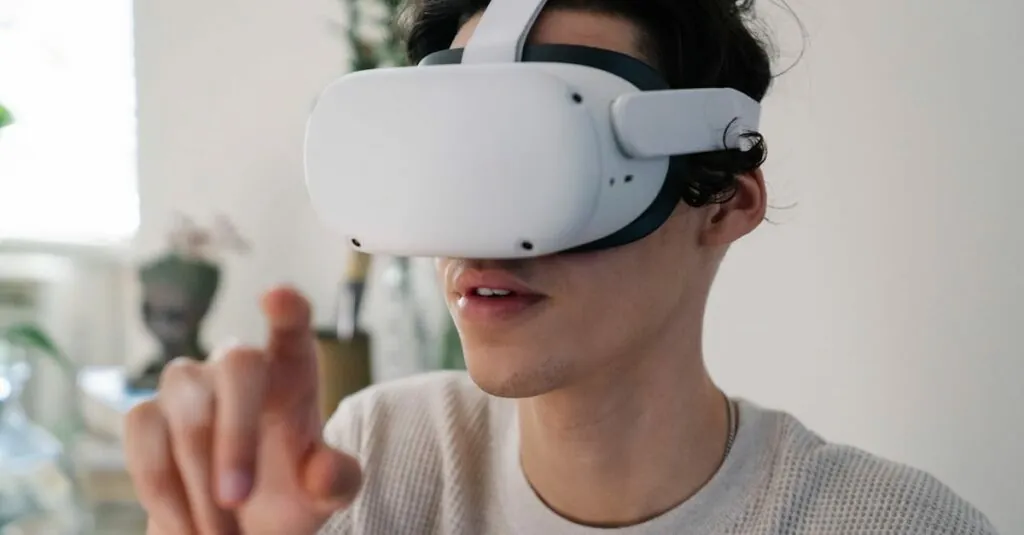Table of Contents
ToggleIn a world where factories are evolving faster than a toddler on a sugar rush, augmented reality manufacturing is leading the charge. Imagine a production line where workers don’t just see parts but interact with 3D holograms, making mistakes as rare as a unicorn sighting. This tech isn’t just a flashy gimmick; it’s a game changer that’s reshaping how products are made.
Overview of Augmented Reality Manufacturing
Augmented reality (AR) enhances manufacturing processes by overlaying digital information onto the physical world. This technology aids workers in visualizing complex assembly processes through 3D holograms. These interactive elements improve accuracy and efficiency, minimizing the likelihood of errors.
AR applications in manufacturing range from training employees to maintenance support. Workers engage with virtual guides that provide step-by-step instructions in real time. Companies adopting these tools report significant time savings during training, as employees learn faster through immersive experiences.
Using AR for remote support has gained traction in recent years. Technicians can receive real-time assistance from experts located anywhere. This capability accelerates problem resolution, reduces downtime, and enhances overall productivity.
Furthermore, AR streamlines quality control by providing instant access to inspection data. Operators can compare assembled products with digital specifications through augmented interfaces. Enhanced precision ensures that products meet quality standards before reaching consumers.
Metrics from various studies indicate that AR technology can lead to productivity increases of up to 25%. These improvements instigate cost reductions and increase competitiveness in the market. As factories continue to integrate AR, organizations become better equipped to adapt to changing production demands.
Implementing AR solutions requires a strategic approach. Companies must assess their current systems and identify areas where AR can deliver the most significant impact. Such assessments ensure that investments lead to meaningful advancements in productivity and efficiency.
Key Technologies Involved
Augmented reality (AR) incorporates various technologies to enhance manufacturing processes. These technologies fundamentally improve productivity and accuracy on the factory floor.
Virtual Reality vs. Augmented Reality
Virtual reality (VR) immerses users in a completely digital environment, while augmented reality overlays digital information onto the physical world. AR offers a blend of real and virtual interactions, which aids workers in comprehending complex assembly tasks. Unlike VR, which removes users from their surroundings, AR maintains a connection to the physical space, increasing efficiency in real-time applications. Workers benefit from AR’s real-time feedback and guidance, making it an essential tool in modern manufacturing.
Mixed Reality Applications
Mixed reality (MR) combines elements of both AR and VR, allowing users to interact with digital content in the real world. This technology presents unique opportunities for manufacturing by enabling seamless collaboration between remote teams. In mixed-reality applications, holograms can represent assembly instructions or virtual models, supporting complex tasks with visual aids. By integrating MR into workflows, companies can improve decision-making and reduce downtime, ultimately enhancing overall productivity and innovation.
Benefits of Augmented Reality Manufacturing
Augmented reality (AR) manufacturing offers numerous advantages, enhancing operational efficiency significantly. Companies increasingly adopt AR solutions to maximize their competitiveness.
Enhanced Productivity
Increased accuracy results from AR applications during assembly. Workers can visualize components in 3D, reducing mistakes that cause delays. Time savings often reach 25% as employees access real-time data. Streamlined workflows arise from AR guidance, allowing for faster decision-making. Enhanced collaboration emerges when teams share insights instantly. Productivity improvement strengthens overall output and supports growth.
Improved Training and Maintenance
Training processes become more effective through immersive AR experiences. New employees engage with interactive tutorials, increasing retention rates in critical skills. Maintenance support also thrives with AR overlays that provide step-by-step instructions. Technicians access real-time information that aids in diagnosing issues quickly. Overall, AR enhances operational efficiency while minimizing downtime, thereby improving equipment longevity. Investing in AR training brings substantial returns in skill development and maintenance efficiency.
Challenges and Limitations
Implementing augmented reality in manufacturing presents several challenges and limitations that companies must address. Success requires a thorough understanding of these issues.
Technical Constraints
Hardware limitations often hinder augmented reality applications. Many AR devices lack the required processing power or battery life to support continuous use on the factory floor. Software integration presents another challenge, as existing manufacturing systems may not easily interface with new AR tools. Companies face difficulties ensuring compatibility between AR solutions and legacy systems. Furthermore, maintaining data security becomes essential. AR applications that collect and analyze sensitive information raise concerns regarding cybersecurity risks and compliance with industry regulations.
User Acceptance
User acceptance significantly impacts the effectiveness of augmented reality implementations. Workers may resist adopting new technology due to unfamiliarity or fear of job replacement. Training programs become vital for fostering acceptance and demonstrating the benefits of AR tools. Encouraging employees to engage with AR applications promotes a smoother transition. Feedback mechanisms also play a crucial role in identifying concerns and improving system usability. Addressing reservations proactively helps cultivate a positive perception of AR technology within the workforce.
Future Trends in Augmented Reality Manufacturing
Augmented reality is set to transform manufacturing processes further. Enhanced wearables are anticipated to become mainstream, allowing workers to access real-time data hands-free. Smart glasses will likely play a crucial role by overlaying digital instructions directly onto physical components, enabling quicker assembly.
Collaborative AR environments are on the horizon, fostering teamwork across various locations. Such platforms may utilize shared digital spaces where teams can visualize design modifications together, improving communication and reducing errors. The incorporation of artificial intelligence within AR applications will enhance predictive maintenance capabilities. This integration is expected to assist technicians by predicting equipment failures before they occur.
Sustainability initiatives may also benefit from AR advancements. Companies can simulate production processes in virtual environments, identifying areas for waste reduction and efficiency improvements. Automation, when combined with AR, can streamline repetitive tasks, allowing employees to focus on more complex responsibilities that require human insight.
Furthermore, companies exploring AR solutions could see integration with digital twins. This technology permits the creation of virtual replicas of real-world systems, aiding in monitoring and optimizing performance. Employee training is likely to evolve significantly, utilizing AR for immersive simulations that enhance skill development.
As AR continues to mature, data security will remain a priority. With the increased collection of sensitive operational data, robust security frameworks will be essential to protect company information. Emphasizing worker engagement through thorough training programs helps address the potential resistance to new technologies. Adapting to these trends positions companies to leverage AR, ultimately leading to improved productivity and competitiveness in the industry.
Augmented reality is reshaping the manufacturing landscape by enhancing productivity and operational efficiency. As companies embrace AR technology they’re not just improving workflows but also fostering a culture of innovation. The benefits of real-time data access and immersive training experiences are driving significant advancements in accuracy and decision-making.
While challenges exist such as technical limitations and user acceptance, the potential of AR to revolutionize manufacturing processes is undeniable. Future developments in wearables and AI integration promise to further streamline operations and enhance collaboration. As the industry adapts to these changes the focus on effective training and data security will be crucial in maximizing the advantages of augmented reality. Embracing AR is a strategic move that positions manufacturers for sustained growth and competitiveness in an evolving market.




